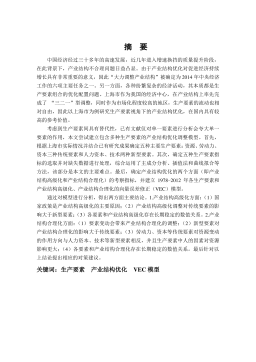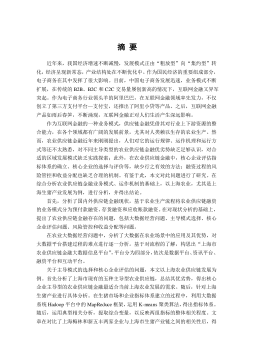后税费时代乡镇政府财政解困问题研究
摘要中国自2000年开始推行农村税费改革,至2006年在全国范围内取消农业税,对于全国而言,在税费改革之后的“后税费时代”,基层财政的出路和前景问题成为目前理论界和实际工作部门面临的迫切需要解决的重大问题。由于地方分权以及公共品的层次性,乡镇财政有其存在的必要性和合理性。在后税费时代乡镇政府应该具有三大职能:一是提供公共产品和公共服务,居民对公共品的需求是有位序的,乡镇政府应该根据农民对公共品的需求以及需求顺序来提供公共品;二是和谐社会目标下的新农村建设职能,按照“生产发展、生活宽裕、乡风文明、村容整洁、管理民主”的总体要求,开展新农村建设;三是民主财政建设职能,乡镇政府要建立公共品需求表达和...
相关推荐
-
我国基层财政困难的制度成因分析与对策研究VIP免费

 2024-09-20 33
2024-09-20 33 -
我国煤电产业链纵向交易合约机制研究VIP免费

 2024-09-20 28
2024-09-20 28 -
生产要素视角下的上海市产业结构优化研究VIP免费

 2025-01-09 7
2025-01-09 7 -
我国银行业结构与经济结构关系研究VIP免费

 2025-01-09 7
2025-01-09 7 -
大数据视角下农业供应链金融研究VIP免费

 2025-01-09 6
2025-01-09 6 -
跨国大型综合超市的规划研究VIP免费

 2025-01-09 6
2025-01-09 6 -
跨境电商农产品质量安全问题研究VIP免费

 2025-01-09 7
2025-01-09 7 -
世界市场的虚拟化与我国国际电子商务发展方向研究VIP免费

 2025-01-09 9
2025-01-09 9 -
中国政府对电力行业的价格规制问题研究VIP免费

 2025-01-09 14
2025-01-09 14 -
中小企业信息化系统集成技术研究VIP免费

 2025-01-09 14
2025-01-09 14
相关内容
-

跨国大型综合超市的规划研究
分类:高等教育资料
时间:2025-01-09
标签:无
格式:PDF
价格:15 积分
-

跨境电商农产品质量安全问题研究
分类:高等教育资料
时间:2025-01-09
标签:无
格式:PDF
价格:15 积分
-

世界市场的虚拟化与我国国际电子商务发展方向研究
分类:高等教育资料
时间:2025-01-09
标签:无
格式:PDF
价格:15 积分
-

中国政府对电力行业的价格规制问题研究
分类:高等教育资料
时间:2025-01-09
标签:无
格式:PDF
价格:15 积分
-

中小企业信息化系统集成技术研究
分类:高等教育资料
时间:2025-01-09
标签:无
格式:PDF
价格:15 积分





